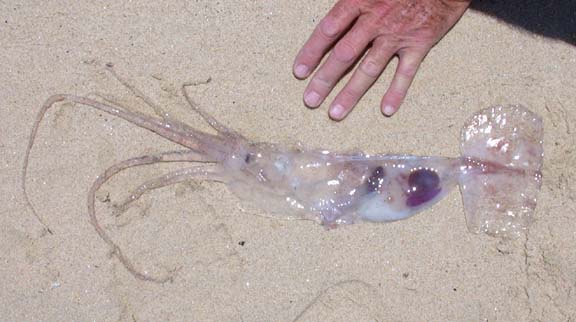
Transparent "Glass" Squid Found at La Paz
![]()
|
NEW SPECIES?--An unusual, almost completely transparent squid found by a panguero near Punta Arena de la Ventana, south of La Paz, Baja California Sur, Mexico, May 27, 2003. Photo by Gene Kira. |
POSSIBLE NEW SQUID SPECIES FOUND BY LAS ARENAS PANGUERO
By Gene Kira, June 9, 2003, as published in Western Outdoor News:
The jury is still out, but there is at least the faint possibility that an unusual, almost completely transparent squid found off Isla Cerralvo during my recent trip to La Paz, Baja California Sur, Mexico, might be a new species.
I had been out fishing at Las Arenas, south of La Paz, on a Fisherman's Fleet panga with roosterfish expert, Bill Mathias, but it had been a real slow day. Bill's trolled ladyfish baits drew exactly one pez gallo strike, south of La Reina rock at the northwest corner of the island, and he released a 40-pounder. That was a nice fish, but Bill's real quarry are roosters more than twice that big.
|
|
This was the third time I'd accompanied Bill and his regular Fisherman's Fleet guide, Isidro, and I now feel that I have a pretty good handle on their roosterfish technique.
Bill slow-trolls the biggest live ladyfish, or sábalo, he can catch, hooked through the upper lip with a small J-hook, which is tied to the outer bend of a large circle hook that floats free in the water, about an inch in front of the bait's nose. When he gets a take, Bill waits maybe two to five seconds, and then pushes the drag to "Strike." There is no rod lift, no swing, and no formal "hook set" of any kind.
Using this technique with 20-pound line, Bill has a very high hookup ratio on big roosterfish. In fact, he called to report that a few days later he'd gone 12 for 13 on fish, to a carefully estimated 44 kilos, or about 96 pounds. (The only roosterfish not hooked solidly that day had swallowed the large bait tail-first and only up to the gills, and so, it never got the hook in its mouth.)
But my La Paz fishing day with Bill was slow, and he caught only his single 40-pounder and nothing else. As we trolled slowly along the beaches of Isla Cerralvo, Bill talked about the island's interesting rock formations (he's a retired geologist), and in my mind, at least, our lack of fish didn't really detract from another enjoyable and educational day in Baja.
|
|
The really interesting part of the day happened right after we returned to the beach, a few hundred yards north of the light at Punta Arena de la Ventana. Isidro ran our panga up onto the sand, and I hopped out, basically looking for a good place to pee.
Behind me on the beach, I heard a panguero's voice call out in Spanish: "Hey, does anybody know what kind of squid this is?"
It is highly unusual for a panguero not to be able to identify any form of sea life from his native area. Ignoring a rather urgent call of nature, I grabbed my camera and trotted back to his panga, and looked down at the sand at what I at first thought was just a jellyfish.
But, nope, it was definitely a squid, and it was so colorless and transparent, you could have read a newspaper page through its body and tentacles. You could see its internal organs, and the only other coloration was some small purple dots, here and there.
There are lots of transparent squids that live deep in the water, but all the ones I was familiar with had small fins and very short tentacles, something like a cuttlefish or a chambered nautilus. This one had huge fins, and long tentacles, possibly a member of the family of deep water bathyscaphoid squids, but if so, a rather atypical one.
I quickly took some photos, and we delivered the squid to Dr. Emelio Barjau González, head of the Marine Biology Department at the Universidad Autónoma de Baja California Sur in La Paz. Dr. Barjau González declared that, although he felt the squid probably lived 200 to 1,000 meters deep, he was unfamiliar with the species. As of this writing, the squid is being taxonomically examined by some specialists, and who knows? Maybe--just maybe--it's a new species. That would be a hoot, for sure.
(Related La Paz articles and reports may be found at Mexfish.com's main La Paz information page. See weekly fishing news, photos, and reports from the major sportfishing vacation areas of Mexico including the La Paz area in "Mexico Fishing News.")
MEXICO FISHING INFO LA PAZ FISHING INFO "WEEKLY MEXICO FISHING NEWS" FISH PHOTO GALLERY
